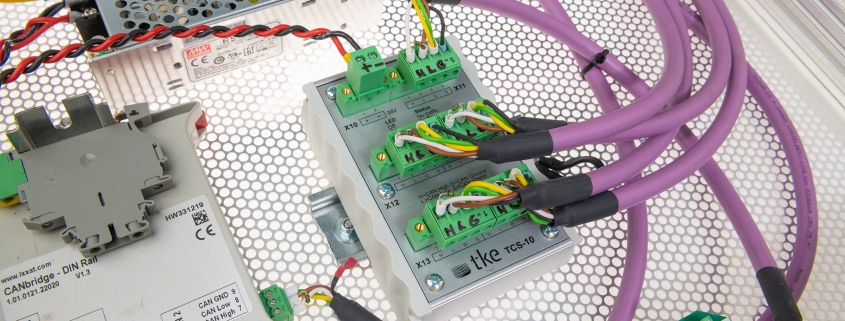How to Update Firmware on the TCS-10 Safely
Updating firmware on the TCS-10 CAN Switch Bridge involves a systematic approach to ensure the device continues functioning optimally. The process requires careful preparation, proper execution, and verification steps to prevent potential issues. By following established guidelines, you can safely update your TCS-10 firmware to access the latest features, security improvements, and bug fixes while minimising the risk of update failures or device damage. Regular firmware maintenance is essential for keeping your CAN-bus network infrastructure reliable and secure.
Understanding firmware updates for your TCS-10 device
Firmware acts as the essential operating software that controls the TCS-10 CAN Switch Bridge’s core functionality. Unlike standard software applications, firmware is embedded directly into the hardware, providing fundamental instructions for how the device operates, communicates, and processes data within CAN-bus networks.
The TCS-10 serves as a critical component in industrial CAN-bus networks, facilitating communication between different segments and devices. Firmware updates for this device typically include enhancements to protocol handling, data throughput optimisation, bug fixes, and security patches that protect against vulnerabilities.
Regular firmware updates ensure your TCS-10 operates with the most current capabilities, allowing for improved performance, compatibility with newer equipment, and protection against potential security threats that could compromise your industrial network infrastructure.
Why is updating the TCS-10 firmware important?
Keeping your TCS-10 firmware current is crucial for maintaining optimal system reliability in industrial environments. Updated firmware delivers enhanced functionality through improved algorithms, optimised data handling, and expanded feature sets that can significantly boost your CAN-bus network performance.
Security improvements represent another vital aspect of firmware updates. As cyber threats evolve, firmware updates often contain patches for vulnerabilities that could otherwise expose your industrial systems to security risks. Without these updates, your network may remain susceptible to known exploits.
Bug fixes address operational issues that might cause intermittent failures, communication errors, or other unpredictable behaviours. These corrections ensure consistent operation, particularly in critical industrial applications where downtime carries significant consequences.
Outdated firmware can lead to compatibility issues with newer equipment, reduced network efficiency, and increased vulnerability to security threats. In industrial settings, these risks can translate to production delays, equipment damage, or even safety concerns—making regular firmware maintenance an essential operational practice.
What preparation steps should you take before updating TCS-10 firmware?
Before initiating a firmware update for your TCS-10, thorough preparation is essential to prevent potential complications. Begin by backing up your current configuration settings, which ensures you can restore your specific parameters if needed after the update process.
Verify system compatibility by checking that the new firmware version is appropriate for your specific TCS-10 hardware revision. Using incompatible firmware could render your device inoperable, so this verification step is critical.
Essential preparation steps include:
- Download the correct firmware version from the official TKE Sweden website or authorized source
- Ensure a stable power supply to prevent interruptions during the update process
- Schedule the update during a maintenance window when network downtime won’t impact operations
- Document current settings and configurations for reference
- Check that your update computer has the necessary software tools installed
- Verify network connections between your computer and the TCS-10 device
Additionally, notify relevant team members about the planned update to prevent confusion or unintended interruptions during the process.
How do you perform a safe firmware update on the TCS-10?
Performing a safe firmware update on your TCS-10 requires following a structured process to minimize risks. Begin by connecting your computer to the device using the appropriate configuration interface, typically through a USB connection or network port, depending on your specific model.
Step-by-step update process:
- Connect to the TCS-10 using the configuration software provided by TKE Sweden
- Verify the connection is stable before proceeding
- Select the firmware update option in the configuration software
- Browse and select the firmware file you downloaded from the official source
- Initiate the update process and allow it to complete without interruption
- Monitor the progress indicators throughout the update
- Wait for confirmation that the update has been successfully installed
- Restart the TCS-10 when prompted to activate the new firmware
During the update, the device will typically display indicator lights showing the progress. These may flash in specific patterns to indicate the update is ongoing. Do not disconnect power or communication cables during this critical phase.
After completion, verify the update was successful by checking the firmware version in the configuration software. You should also test basic functionality to ensure the device is operating correctly with the new firmware.
What should you do if a firmware update fails?
If your TCS-10 firmware update encounters problems, remain calm and follow systematic recovery procedures to restore functionality. Update failures typically manifest through error messages, abnormal indicator light patterns, or the device becoming unresponsive.
Common error scenarios and solutions include:
- Connection Lost During Update: Restart the update process, ensuring stable power and communication connections
- Verification Failed Error: Re-download the firmware file as the original may be corrupted
- Incompatible Version Error: Verify you’re using the correct firmware version for your specific hardware revision
- Device Not Responding: Attempt a power cycle by disconnecting power for 30 seconds before reconnecting
Many TCS-10 devices include a recovery mode that can be accessed by following specific power-up sequences or using hardware reset buttons. Consult your device documentation for the exact procedure relevant to your model.
If standard recovery methods fail to resolve the issue, contact technical support for professional assistance. Before making contact, document the specific error messages, the firmware version you attempted to install, and the steps you’ve already taken to troubleshoot the problem.
Key takeaways for maintaining your TCS-10 device
Effective maintenance of your TCS-10 requires a proactive approach to firmware management. Establishing a regular update schedule helps ensure your device consistently benefits from the latest improvements and security patches without creating unexpected operational disruptions.
Best practices for long-term TCS-10 maintenance include:
- Check for firmware updates quarterly or subscribe to update notifications
- Maintain a firmware version history document for your specific devices
- Test updates in non-critical environments before deploying to production systems
- Keep configuration backups for each device, updated whenever settings change
- Document any custom settings or special configurations
We recommend creating a maintenance calendar that includes regular firmware checks and scheduled update windows. This systematic approach helps prevent the accumulation of multiple update versions, which can sometimes complicate the update process.
For industrial systems with critical uptime requirements, consider establishing a testing protocol for firmware updates to verify compatibility with your specific application before deployment to production environments. This additional step can significantly reduce the risk of unexpected issues following firmware changes.
By following these guidelines, you’ll ensure your TCS-10 devices remain secure, efficient, and reliable components within your industrial CAN-bus networks for years to come.
Interested in real-world automation solutions?
Browse our case studies to discover how we support safe and efficient operations through smart control and networking systems

 MARIN
MARIN
